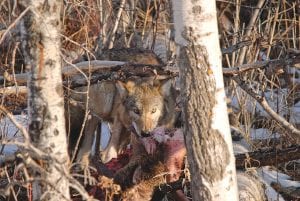Timberwolves (gray wolves) seem to be healthy in Cook County despite the hunt sanctioned by the state of Minnesota for the last three years. DNR wildlife researchers estimate there are 2,423 wolves in Minnesota, up about 200 wolves over last year. The gray wolf population peaked at 3,020 in 2004. On December 19, 2015, U.S. District Court Judge Beryl Howell overturned a 2011 decision by the U.S. Fish and Wildlife Service to delist the gray wolf, a move that for the time being protects the wolf from being hunted in Michigan, Wisconsin and Minnesota.

Despite growing in numbers— at least in Minnesota— gray wolves have once again been placed on the endangered species list, effectively ending the state’s hunting/trapping season.
On Friday, December 19, 2015, a federal judge overturned a 2011 decision by the U.S. Fish and Wildlife Service (FWS) to delist the gray wolf. In 2012 the state of Minnesota began what has become a controversial hunting/trapping season, favored by ranchers and some hunters and opposed by animal rights advocates.
This year the Minnesota Department of Natural Resources (DNR) set a quota of 250 wolves to be harvested over a two-part season. Hunters and trappers filled out the quota for Northeastern Minnesota earlier this season than in the previous two years of the hunt. All told, 272 wolves were taken in three hunting zones before the Minnesota hunt was ended.
DNR wildlife researchers estimate there are 2,423 wolves in Minnesota, up about 200 wolves over last year. The gray wolf population (or timber wolf as it is sometimes called) peaked at 3,020 in 2004.
This year 35,000 people applied for 3,800 hunting/ trapping licenses. Fewer than one in 10 hunters got a wolf.
In her 111-page ruling, U.S. District Judge Beryl Howell sided with the wildlife groups who have fought since 2003 to keep the gray wolf on the endangered species list. The Humane Society of the U.S. said the judge, “chided the USFWS” for failing to explain why it ignored the potential for further recovery of wolves into areas of its historic range that remain viable habitat for the species.
Howell also argued the USFWS allowed “virtually unregulated” killing of wolves in Michigan, Wisconsin and Minnesota and she asked how that does not constitute a threat to the wolves. Her ruling places the gray wolf back on the endangered list in Wisconsin and Michigan and on the threatened list in Minnesota.
Wolves were first put on the federal endangered species list in 1974 after being hunted and poisoned nearly out of extinction in the lower 48 states.
Born Free USA, Help Our Wolves Live and Friends of Animals and Their Environment joined the Humane Society of the U.S. in the lawsuit.
In a press release, Jonathan Lovvorn, senior vice president and chief counsel for animal protection litigation at the Humane Society of the United States, said, “In the short time since federal protections have been removed, trophy hunters and trappers have killed more than 1,500 Great Lakes wolves under hostile state management programs that encouraged dramatic reductions in wolf populations. We are pleased that the court has recognized that the basis for the delisting decision was flawed, and would stop wolf recovery in its tracks.”
When the Cook County News-Herald asked if the judge used science in her ruling, famed wolf researcher L. David Mech said, “No. It’s clear from the ruling that the decision was made based on various legal technicalities, not biological realities.”
Mech, senior scientist with the Biological Resource Division, U.S. Geological Survey and Adjunct Professor in the Department of Fisheries, Wildlife and Conservation Biology, and Ecology, Evolution and Behavior at the University of Minnesota, has studied wolves since 1958.
He also said, “There will probably be an increase in illegal wolf killing. That would increase if the ruling stands until next hunting season. However, conceivably Congress will delist the wolf legislatively and not subject to legal challenge, as happened with Montana and Idaho when the public got fed up with the legal rulings that continued to keep the wolf listed.”
Minnesota DNR media spokesman Chris Niskanen warned that under the current ruling people can’t kill a wolf, which threatens either their pets or livestock. The only way a wolf can be harmed is if it threatens a human life, he said. Niskanen also said the decision to halt the wolf hunt could be reversed by next fall.
Mech joined with Dick Thiel, author, wildlife consultant, retired wolf biologist with the Wisconsin DNR, Mike Phillips, author, executive director of the Turner Endangered Species Fund and project leader for wolf restoration in Yellowstone National Park, and Nancy Gibson, naturalist and author, for a 30-minute conference call with journalists to explain their side of the judge’s ruling.


Loading Comments